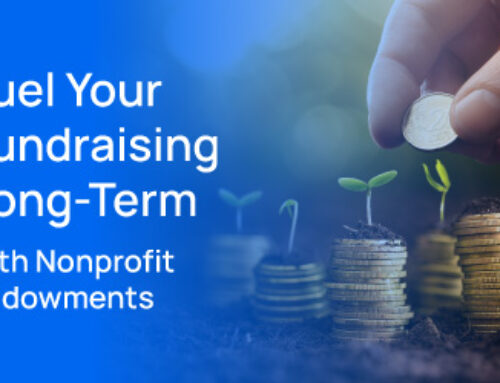
With Giving Tuesday and the end-of-year giving season fast approaching, your nonprofit is likely ramping up efforts to reach its annual fundraising goals. Whether you’re planning holiday events or social media campaigns, incorporating texts into your promotion strategy can have a big impact on your success.
Text marketing, also known as SMS marketing, can help your organization engage supporters, build relationships, and ultimately boost your fundraising results. We’ll cover five best practices you can use to improve your texting strategy and earn more for your mission:
- Ask every supporter to opt in.
- Segment your list of contacts.
- Write tailored messages for every occasion.
- Encourage supporters to respond directly.
- Keep an eye on your metrics.
Any nonprofit can benefit from these best practices, even if you’re new to text marketing or have limited resources. Let’s dive in so you can start driving more donations!
1. Ask every supporter to opt in.
Text marketing works on an opt-in basis, so the first step in developing or improving your text communication strategy is asking supporters to opt in. Once you have a supporter’s contact information and permission to text them, you can use texts as a critical touchpoint for building relationships that lead to more donations and increased involvement.
Give your nonprofit more chances to interact with donors by asking every existing donor to opt in to receive texts from your organization. Beyond donors, you can also ask your volunteers, social media followers, and those who sign up for your email list. The more people you get to opt in, the more supporters you can cultivate relationships with over text.
Streamline the signup process by adding a text opt-in form to your website’s homepage or donation confirmation page. If you have an automated welcome email series for new supporters, you can also schedule an email that asks them to sign up for texts. Emphasize that opting into text messages will allow supporters to get quicker updates and that they can opt-out at any time.
2. Segment your list of contacts.
Once you have a sizable contact list, start segmenting contacts into smaller groups to send more personalized and relevant messages. While there will be times you send bulk texts to your entire donor base, you’ll want to send tailored messages to specific segments more often. With segmentation, you can be confident that messages will resonate with recipients and that they’ll want to continue receiving your texts.
Common ways to segment supporters include grouping them by:
- Giving level and frequency
- Engagement history
- Volunteer status
- Personal and charitable interests
- Demographics like age, career, and location
To make segmentation easier, consider investing in a text marketing application that integrates tightly with your CRM. For example, adding a Salesforce SMS app to your nonprofit’s Salesforce database allows you to quickly create segments based on your existing donor data. With this technology, you can even automatically pull supporter data into individual texts, such as first names and donation amounts.
3. Write tailored messages for every occasion.
Texts are extremely versatile, so you can use them for a variety of types of fundraising messages. Take a look at the following examples of texts you might send for different occasions and purposes:
- Donation appeal: Chris, time is running out to make a contribution to our Giving Tuesday campaign. Donate by midnight to help us provide clean water to those in need.
- Fundraising event invitation: Damien, you’re invited to our annual golf fundraiser on 9/27 at 2pm! RSVP here to join us for a fun day out in support of our local after-school program.
- Thank-you text: Thank you for your $20 donation to the Puppies for Peace campaign, Ella! We couldn’t make a difference without you!
- Campaign update: Thank you again for your donation to our hurricane relief campaign! With your help, we raised $200,000 for those affected by the devastation in Puerto Rico.
As you draft your messages, focus on incorporating clear calls to action, using personalized language, and appealing to supporters’ emotions. Remember to keep all of your texts short, since some messaging apps and carriers split up any messages longer than 160 characters.
4. Encourage supporters to respond directly.
Along with texts’ speed and unparalleled open rates, one of the biggest benefits of text marketing is how easy it is for your recipients to respond quickly and directly. This type of easy two-way communication is beneficial for a number of reasons, including:
- Messaging supporters one-on-one feels highly personal and helps you develop relationships.
- Supporters can get more information quickly by asking any questions they have about a message.
- Getting direct feedback allows your nonprofit to learn more about your donors.
For example, say that you sent a supporter named Jacob a text thanking him for his donation and letting him know that it may be eligible for corporate donation matching. Within 10 minutes, Jacob responds by asking what matching gifts are and how to find out if he’s eligible. You quickly send him a link to more information and instructions, and he submits his match request. Because of this quick exchange, your nonprofit earns an additional donation and strengthens its relationship with Jacob.
You can encourage supporters to respond by sending requests for feedback, text surveys, or just letting them know that they can text back with any questions. According to eCardWidget, asking donors for feedback like this shows them that you value their opinions and helps you boost donor retention.
5. Keep an eye on your metrics.
Finally, like any other fundraising strategy, you should track success metrics for your text messages and use them to evaluate your texts’ effectiveness. Doing so helps you see which types of messages resonate most with recipients and where you may need to improve your strategy.
Get started by tracking these common text marketing performance metrics:
- Click-through rate is the percentage of recipients who click on the links you include in your messages.
- Response rates represent how many recipients respond to your texts by replying directly or filling out a survey.
- Conversion rates tell you how many people take a certain action after receiving your texts, such as making a donation or signing up to volunteer.
- Opt-out rates are the percentage of supporters that opt-out after subscribing to your organization’s texts.
It can be difficult to track all of these metrics manually, but Mogli explains that the best SMS apps will include built-in reporting capabilities that help you quickly measure your success and guide your strategy in the right direction.
The Bottom Line
With these tips, your nonprofit can build a text marketing strategy that motivates donors to give in no time. Remember to craft messages that align with your supporters’ interests and preferences, and don’t be afraid to experiment with new techniques.
About the Author
 Christina Marmor is a tenacious marketing leader who combines grace, grit, and creative joy to drive innovation, evolve mindsets, and accelerate transformation. She is obsessed with personalizing experiences to drive connection and engagement. Christina is a life-long figure skater. When not championing Mogli, you’ll most likely find her on a lacrosse field cheering on her son or at the ice rink supporting her daughter’s figure skating journey.
Christina Marmor is a tenacious marketing leader who combines grace, grit, and creative joy to drive innovation, evolve mindsets, and accelerate transformation. She is obsessed with personalizing experiences to drive connection and engagement. Christina is a life-long figure skater. When not championing Mogli, you’ll most likely find her on a lacrosse field cheering on her son or at the ice rink supporting her daughter’s figure skating journey.





